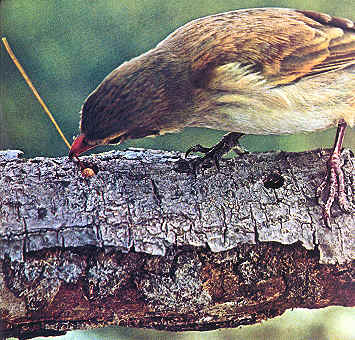|
|
An Improvised Beak
The woodpecker finch, residing on the galapagos islands, is the most amazing of darwin's finches. Its talents include tool use as well as tool fabrication. In the above photograph, the finch is prying grubs out of a tree branch with a cactus spine. A woodpecker's long barbed tongue enables it to extract grubs from branches without the assistance of a tool. The woodpecker finch compensates for its short tongue by grasping a cactus spine in its beak and prying grubs out of the branch. The finch then drops the cactus spine and holds it under its foot while eating the grub. The cactus spine is then carried to the next branhch to be used again. Observations by Millikan and bowman(1967) reveal that the finches adjust their posture and manipulation of the tool according to its size and shape. They also discovered that the woodpecker finches were more likely to seek out and use tools when they were hungrier. Miilikan and Bowman also conducted a study in which a different species of finch from the galapagos islands, large-cactus ground finch, was caged next to a group of woodpecker finches. Although the large-cactus ground finches do not use tools to probe branches while in their natural environment, their captivity next to the woodpecker finches resulted in their acquisition of that tool use. However, other species of finches than the large-cactus ground finch did not learn to use tools as probes when they were caged next to woodpecker finches. A researcher was fortunate enough to observe a young woodpecker finch's acquistion of the skill of using the cactus spine. The finch began by attempting to obtain the grubs simply by using its beak. When that system frequently failed, the finch implemented a twig in order to reach further into the branch. Another finch was observed snapping off a part of a forked twig in order to better serve its purposes. Millikan and bowman(1967) also observed woodpecker finches shortening long cactus spines in order to form more manageable tools. This manipulation of an object for tool use is particularly impressive. Brown(1975) posits that woodpecker finches would be replaced by woodpeckers or nuthatches if either of those species were to come to the galapagos islands. His basis for this theory is that woodpeckers and nuthatches have more effective morphological means for accomplishing what the woodpecker finch does with tools.
|
